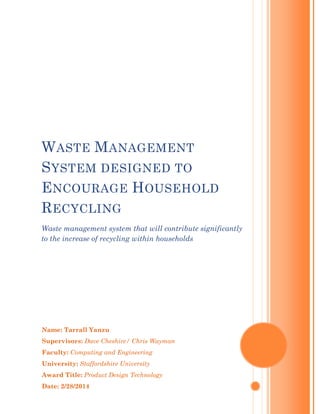Tarrall Yanzu conducted research on waste management systems to encourage household recycling. He reviewed literature on the types and impacts of waste, finding that while household recycling rates have increased in the UK, more can be done to encourage full participation and reduce waste sent to landfills. His research covered existing waste collection and composting systems. He plans to develop a technical specification and concept designs for a new waste management system to further increase household recycling rates.










































![7. REFERENCES
Arena, U., Mastellone, M. and Perugini, F., 2003. Life Cycle assessment of a plastic
packaging recycling system. The International Journal of Life Cycle Assessment,
[online] 8(2), pp.92-98. Available at:
<http://link.springer.com/article/10.1007/BF02978432> [Accessed 17 Apr. 2014]
Bartelings H. and Sterner, T. 1999. Household Waste Management in a Swedish
Municipality: Determinants of Waste Disposal, Recycling and Composting. 13 (4),
pp. 473-491.
Environment-agency.gov.uk. (2014).Environment Agency - Waste management
advice. [online] Available at:
http://www.environmentagency.gov.uk/business/sectors/wastemanagement.aspx
[Accessed: 6 Jan 2014].
Gevorgyan, S., Jorgensen, M. and Krebs, F. (2008). A setup for studying stability
and degradation of polymer solar cells. Solar Energy Materials and Solar Cells,
92(7), pp.736--745
Hamer G. (2003). ‘Biotechnology Advances’. Solid waste treatment and disposal:
effects on public health and environmental safety. 22 (1), 71-79.
Hill, T. and Westbrook, R. 1997. SWOT analysis: it's time for a product recall. Long
range planning, 30 (1), pp. 46—52
Nyuk Ling C. (2013). ‘Load size or starter cultures in kitchen-waste’
composting. International Journal of Recycling of Organic Waste in Agriculture. 2
(2), 10.
Siegle L (2006). Recycle the essential guide. London: Black dog publishing. 192-199.
Thomas P. (2013). Statistics on waste managed by local authorities in England in
2012/13 .Available:
https://www.gov.uk/government/uploads/system/uploads/attachment_data/file/2556
10/Statistics_Notice1.pdf. Last accessed 23rd November 2013.
Video. (2008). A river of waste. Available: http://topdocumentaryfilms.com/river-
waste/. Last accessed 19th November 2013](https://image.slidesharecdn.com/2e77012a-3264-4747-a7fd-a96e176a8fd3-150601222039-lva1-app6892/85/Waste_Management_System_-_FYP_3-43-320.jpg)
![8. BIBLIOGRAPHY
Aircarcompressedairtechnology.com, (2014). compressed air technology - the CAT 34 engine produces
zero pollution in the MiniCAT Air Car. [online] Available at:
http://www.aircarcompressedairtechnology.com/engine-eng.php [Accessed 1 Mar. 2014].
Blaine, E. (2014). Hip Kitchen Composting. [online] TrendHunter.com. Available at:
http://www.trendhunter.com/trends/kitchen-composting-bio-pod-organic-waste-storage-system
[Accessed 10 Nov. 2013].
DeFreitas, S. (2002). Wind-Powered Composter Concept Design Works 10X Faster | EarthTechling.
[online] EarthTechling. Available at: http://earthtechling.com/2010/06/wind-powered-composter-
concept-design-works-10x-faster/ [Accessed 12 Nov. 2013].
Devries, D. (2014). How Does a Shredder Work? | eHow. [online] eHow. Available at:
http://www.ehow.com/how-does_4606570_a-shredder-work.html [Accessed 18 Apr. 2014].
David, I. (2014). How Does a Rock Crusher Work? | eHow. [online] eHow. Available at:
http://www.ehow.com/how-does_5244650_rock-crusher-work_.html [Accessed 12 Apr. 2014].
Environment Team | Eco-friendly Gallery, (2003). Eco Cleaner – Compost Making Dishwasher.
[online] Available at: http://www.environmentteam.com/concept/eco-cleaner-compost-making-
dishwasher/ [Accessed 12 Nov. 2013].
E., C. (2013). How Does a Wood Chipper Work? – DR's Country Life Blog. [online] DR's Country Life
Blog. Available at: http://blog.drpower.com/how-does-a-wood-chipper-work/ [Accessed 14 Feb. 2014].
Google.co.uk, (2014). recycling systems for home - Google Search. [online] Available at:
https://www.google.co.uk/search?q=recycling+systems+for+home&source=lnms&tbm=isch&sa=X&ei
=6W0CU-20B4iBhQfAh4DABA&ved=0CAcQ_AUoAQ&biw=1304&bih=683#imgdii=_ [Accessed 6
Jan. 2014].
Harris, T. (2014). HowStuffWorks "How Vacuum Cleaners Work". [online] HowStuffWorks. Available
at: http://home.howstuffworks.com/vacuum-cleaner.htm [Accessed 6 Apr. 2014].
Houseautomator.com, (2013). Futuristic Kitchen: Ekokook Water and Waste Management System by
Faltazi | Home Automation. [online] Available at: http://www.houseautomator.com/arch/kitchen-
automation/futuristic-kitchen-ekokook-water-and-waste-management-system-by-faltazi.html
[Accessed 16 Dec. 2013].
Inspirationgreen.com, (2014). Kitchen of the Future. [online] Available at:
http://www.inspirationgreen.com/philips-kitchen-of-the-future.html [Accessed 19 Feb. 2014].
http://www.yankodesign.com/2011/04/04/city-compost-bin/
Nottingham.ac.uk, (2014). Bottled Water - the facts. [online] Available at:
http://www.nottingham.ac.uk/etc/news-water.php [Accessed 27 Mar. 2014].](https://image.slidesharecdn.com/2e77012a-3264-4747-a7fd-a96e176a8fd3-150601222039-lva1-app6892/85/Waste_Management_System_-_FYP_3-44-320.jpg)
![Qualitylogoproducts.com, (2014). The Different Types of Plastic and Their Number Classifications
(Codes) - Quality Logo Products, Inc.. [online] Available at:
http://www.qualitylogoproducts.com/lib/different-types-of-plastic.htm [Accessed 20 Mar. 2014].
Rfimmunity.com, (2012). Engineering and Filter Technology. [online] Available at:
http://www.rfimmunity.com/?CategoryID=290&ArticleID=353&sng=1 [Accessed 19 Dec. 2013].
Recycling Guide, (2008). Recycling in Industry. [online] Available at: http://www.recycling-
guide.org.uk/industry.html [Accessed 8 Jan. 2014].
Redwave.at, (2014). Sorting machine for plastic recycling, brominated out of shredded - Redwave.
[online] Available at: http://www.redwave.at/en/plastics-sorting/redwave-xrf-p.html [Accessed 6 Apr.
2014].
Recycling Guide, (2010). Recycling facts and figures. [online] Available at: http://www.recycling-
guide.org.uk/facts.html [Accessed 25 Mar. 2014].
R&R Associates, (2012). Kitchen Compost Machine. [online] Available at:
http://www.rnrassociates.com/wordpress/kitchen-compost-machine/ [Accessed 26 Nov. 2013].
Schiller, A. (2010). Recycle | Earth911.com. [online] Earth911.com. Available at:
http://earth911.com/news/2010/10/25/why-people-dont-recycle/ [Accessed 5 Mar. 2014].
Starbucks Coffee Company, (2014). Recycling & Reducing Waste| Starbucks Coffee Company.
[online] Available at: http://www.starbucks.com/responsibility/environment/recycling [Accessed 22
Mar. 2014]
Thomasnet.com, (2014). Plastic Bottle Manufacturing. [online] Available at:
http://www.thomasnet.com/articles/materials-handling/plastic-bottle-manufacturing [Accessed 12
Mar. 2014]
Tuvie.com, (2009). Smellfree Compost Bin : The Ultra Efficient Odorless Compost Bin Concept |
Tuvie. [online] Available at: http://www.tuvie.com/smellfree-compost-bin-the-ultra-efficient-odorless-
compost-bin-concept/ [Accessed 10 Nov. 2013].
Waste2-0.com, (2014). Waste 2.0 | food waste digester. [online] Available at: http://www.waste2-
0.com/ [Accessed 16 Dec. 2013].
Yankodesign.com, (2009). C/N Compost Bin by La Seconde d'Après » Yanko Design. [online]
Available at: http://www.yankodesign.com/2011/04/04/city-compost-bin/ [Accessed 26 Nov. 2013].
YouTube, (2014). simplehuman sensor trash cans - live more efficiently. [online] Available at:
https://www.youtube.com/watch?v=QRP--xH5hGc [Accessed 16 Jan. 2014].](https://image.slidesharecdn.com/2e77012a-3264-4747-a7fd-a96e176a8fd3-150601222039-lva1-app6892/85/Waste_Management_System_-_FYP_3-45-320.jpg)







